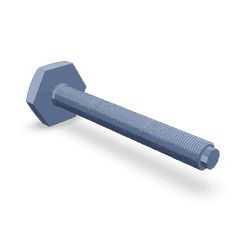This truck part is made by Cummins®. We guarantee that all of our parts are from the OEM (original equipment manufacturer), ensuring a proper fit and quality manufacturing.
We honor the warranty provided by the original equipment manufacturer.
The Screw, Forcing Part #3163057 by Cummins is a component that plays a role in the operational efficiency of commercial trucks. Cummins, a well-established manufacturer in the automotive industry, produces this part with precision engineering. The significance of such components in heavy-duty trucks cannot be overstated, as they contribute to the overall reliability and performance of the vehicle 1.
Basic Concepts of Screw, Forcing
The Screw, Forcing mechanism operates on the principle of converting rotational motion into linear force. This is achieved through the helical grooves of the screw, which, when rotated, move along the axis of the screw, generating force. In the context of a truck’s engine or transmission, this mechanism is utilized to apply force in a controlled and efficient manner, contributing to the smooth operation of various systems 2.
Purpose and Function
The Screw, Forcing Part #3163057 is designed to apply force in specific applications within the truck’s system. Its role involves providing mechanical advantage, which allows for the efficient transfer of force from one component to another. This part contributes to the truck’s efficient operation by ensuring that force is applied precisely where needed, enhancing the overall performance of the vehicle 3.
Key Features
This Cummins part is constructed with high-quality materials to ensure durability and performance. Its design specifications include precise threading and a robust build, which are critical for its function. Unique attributes such as corrosion resistance and high tensile strength further enhance its performance and longevity in demanding commercial truck environments.
Benefits
Utilizing the Screw, Forcing Part #3163057 offers several benefits to fleet operators. It contributes to improved operational efficiency by ensuring that force is applied effectively within the truck’s system. Additionally, its reliable performance reduces the likelihood of downtime, offering cost-saving advantages. The part’s durability also means less frequent replacements, further contributing to cost efficiency.
Installation and Integration
Proper installation of the Screw, Forcing Part #3163057 is vital for its optimal performance. Guidelines for installation include ensuring that the part is correctly aligned and securely fastened within the truck’s system. Precautions such as checking for compatibility with existing components and following manufacturer recommendations are necessary to avoid issues and ensure the part functions as intended.
Troubleshooting and Maintenance
Common issues with the Screw, Forcing Part #3163057 may include wear and tear or misalignment. Troubleshooting involves checking for these issues and making necessary adjustments or replacements. Maintenance tips include regular inspection for signs of wear, ensuring proper lubrication, and following manufacturer guidelines for care. These practices help prolong the part’s lifespan and maintain consistent performance.
Cummins Overview
Cummins Inc. is a leading manufacturer in the automotive industry, known for its diesel engines and related technologies. With a rich history of innovation, Cummins offers a wide range of products designed to meet the demands of various applications. The company’s commitment to quality and performance is evident in its extensive product line, which includes precision components like the Screw, Forcing Part #3163057.
Role of Part 3163057 Screw, Forcing in Engine Systems
In the realm of engine maintenance and repair, the Screw, Forcing Part #3163057 assumes a significant role, particularly when addressing the crankshaft seal replacer. This component is instrumental in ensuring the secure and precise installation of the crankshaft seal, a part that is essential for maintaining the integrity of the engine’s lubrication system.
When replacing a crankshaft seal, the Screw, Forcing is utilized to apply the necessary pressure to seat the seal correctly within its housing. This process is vital for creating a leak-proof barrier that prevents oil from escaping the crankshaft area, which could lead to lubrication failure and subsequent engine damage. The Screw, Forcing ensures that the seal is not only properly positioned but also compressed to the exact specifications required for optimal performance.
Furthermore, the use of the Screw, Forcing in conjunction with the crankshaft seal replacer enhances the overall efficiency of the seal installation process. It allows for a more controlled and consistent application of force, reducing the risk of human error that might occur with manual installation methods. This precision is particularly important in high-performance engines where even minor discrepancies can affect engine reliability and performance.
Conclusion
The integration of the Screw, Forcing Part #3163057 with the crankshaft seal replacer is a testament to the meticulous engineering that goes into maintaining engine components. It underscores the importance of using specialized tools to achieve the highest standards of installation and repair, ultimately contributing to the longevity and efficiency of the engine system.
SPECIFICATIONS
RECOMMENDED PARTS
* Variable geometry turbocharger and electronic actuator repairs are not eligible to be claimed as over-the-counter under New or ReCon parts warranty for parts installed after October 1, 2018.
* Diesel Oxidation Catalyst (DOC), Diesel Particulate Filter (DPF), Selective Catalyst Reduction (SCR) catalyst, and Electronic Control Module (ECM) repairs are not eligible to be claimed as over-the-counter under New or ReCon parts warranty for parts installed after January 1, 2020.
* These restrictions are only applicable to New parts and ReCon parts coverages for the components listed above sold to a customer in the US or Canada. All other coverages are excluded. All other regions are excluded.








